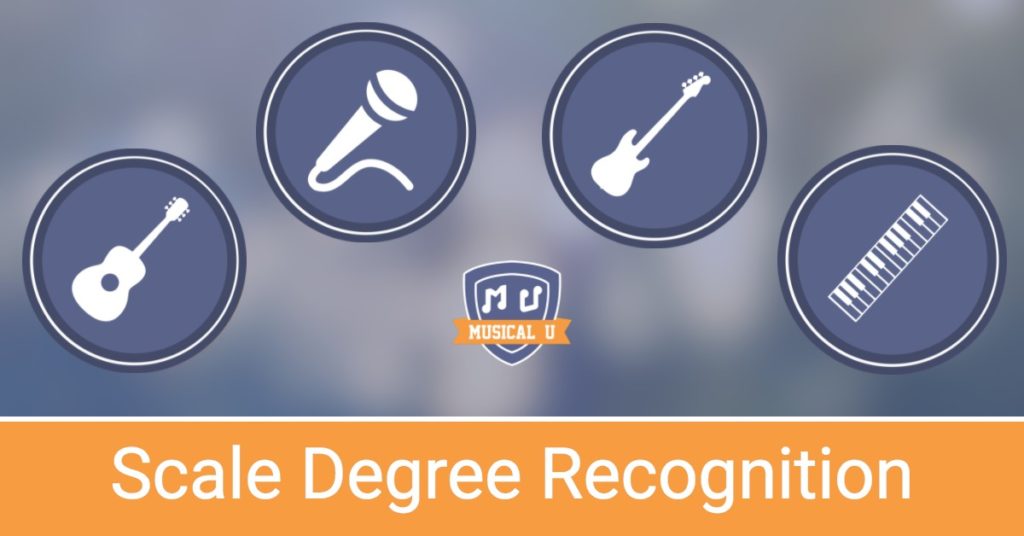Learning to recognise notes by ear can seem overwhelmingly difficult. There’s one way to make it much simpler though: because most notes come from the scale the music was written with, learning to recognise the notes of the scale by ear lets you quickly narrow things down to the most likely right notes.
Inside Musical U we have modules dedicated to the solfa (a.k.a. solfege) approach to scale degree recognition, as well as intervals and extending the skill to full melodies.
In this month’s Instrument Packs our Resident Pros tackled this subject and made it easy for MU members to apply this powerful skill directly on guitar, piano, bass and singing.
It’s always fascinating to see how each of our Resident Pros tackles the same topic from different angles and this month was no exception!
Guitar
Guitarists are used to thinking in terms of scales – the fretboard patterns for a major scale, a major pentatonic, or a minor pentatonic will be familiar to any intermediate-level player. But can you identify all the notes of those scales by ear? Can you go from hearing a tune to playing the right notes of that fretboard pattern.
In this Resource Pack our Resident Pro for guitar Dylan Welsh reveals a clever chord-based way to develop the framework you need to recognise scale degrees flexibly and reliably by ear.
Including:
- A simple scale sing-along exercise to get you oriented
- How to use the tonic chord to internalise scale degrees
- A powerful concept to help you spot the non-chord notes
- A play-through exercise you can use in every key to really master this
- MP3 Practice Tracks with melodies in three keys to try playing by ear
Piano
To apply scale degree recognition for practical musical purposes you need to get the hang of two things: relating it to your instrument, and actually working out music using scale degrees, note-by-note.
In her Resource Pack this month our piano Resident Pro Sara Campbell tackles both of these, introducing an exercise and variations to help you get the basics of solfa in place, and then valuable tips and tricks for using this to play melodies by ear.
Including:
- A quick rundown about how scale degrees (solfa or numbers) can be helpful when figuring out a melody by ear
- A simple chords exercise that will help you hone your solfa ears
- Two tips that will help you apply your knowledge of solfa to figure out melodies that have tricky leaps or chromatic alterations
- MP3 Practice Tracks for the chord solfa warmup exercises
Singing
Using your voice to train your ears is something we’re often recommending at Musical U, and Sara and Dylan both recommended sing-along exercises for their instrument Resource Packs this month. For Clare Wheeler, our Resident Pro for singing, it starts and ends with the voice.
Clare included an essential starter skill in her tutorial: how to find the key (and hence the scale!) by ear. She introduced several exercises you can use, and then two practical applications: finding the correct starting note by ear, and creatively improvising using scale degrees.
Including:
- Practicing finding the “one” of the scale by ear
- Singing through the scale degrees
- How to sing intervals using your knowledge of scale degrees
- Finding your starting note for a song
- Some handy tips for jumping straight to each scale degree
- MP3 Practice Tracks to work on these exercises with more examples
Bass
The bassist typically plays a certain role in a band and in this month’s Resource Pack our Resident Pro for bass, Steve Lawson, presented a view on scale degree recognition that’s unique to bassists.
Steve explains how recognising scale degrees based on the key or current chord can help you figure out basslines by ear (or create your own), and introduces several exercises to help you develop this skill.
Including:
- The two ways to apply scale degree recognition for basslines
- Exercises to help you tune in to the root note movement, whatever the full harmony might be doing
- How scale degree recognition can help you playing a specific bassline by ear or coming up with your own to suit the progression
- An everyday activity you can do without your bass to help you improve
- MP3 Practice Tracks providing chord progressions to try figuring out by ear
Coming up next month…
As you may know, a huge number of songs are written with just four chords – or even just three! We’ve asked our Resident Pros to come up with creative ways to get deeply familiar with I-IV-V (“one four five”) chord progressions.
Interested in getting access to these resources and much more, with an Instrument Pack membership? Just choose that option during checkout when you join Musical U, or upgrade your existing membership to get instant access!







